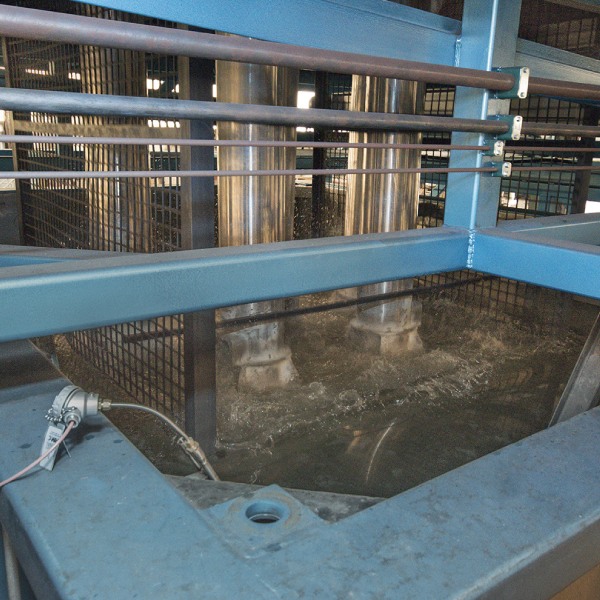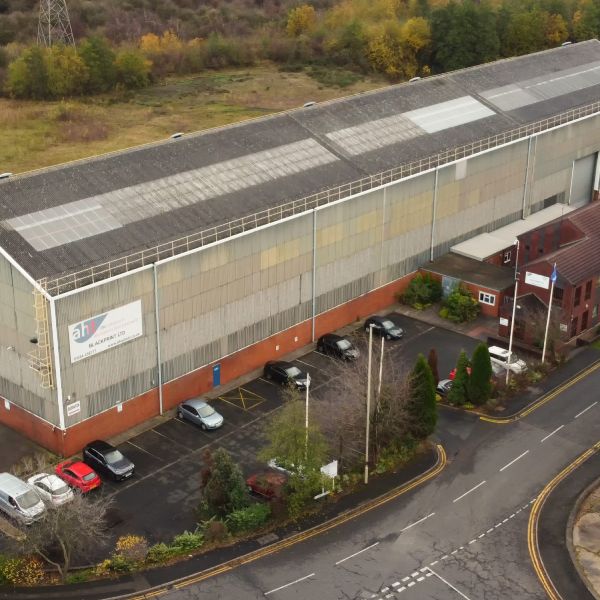Solution Treatment Service
Ranging from sheet metal to large sand castings, a few grams to 2.5 tonnes. Alloy Heat Treatment have 20 furnaces (16 capable of solution treatment) including top loading, front loading and rapid quench (10 second) drop bottom furnaces, most national and international standard requirements can be met for aluminium heat treatment.
Our Solution Treatment Process
- Solution Annealing
- Solution Treatment For The Automotive & Engineering Sectors
- 20 Furnaces (16 capable of solution treatment)
- Material Range: From Sheet Metal To Large Sand Castings
- Solution Furnace Volume = 11.56m³ (2.15m x 2.15m x 2.5m)
We have 20 furnaces (16 capable of solution treatment) most national and international standard requirements can be met for aluminium heat treatment. Ranging from sheet metal to large sand castings, a few grams to 2.5 tonnes, we have the capacity and the volume to heat treat a wide variety of aluminium products.

What Is Solution Treatment?
Solution treatment is a is a metallurgical term for heat treatment processing of certain alloys. It involves heating the metal to a specific temperature, holding it at that temperature for a specified time, and then cooling it rapidly. This process is used to homogenize the alloy, dissolving the required intermetallics, whilst removing cold work and other stresses.
What is Solution Annealing?
When we talk about “Solution Treatment” we are typically discussing what others may call Solution Annealing, it is a like term for Solution Treatment. Solution annealing is usually followed by still air cooling rather than quenching, thus differentiating between solution treatment and solution annealing, where both heat treatment processes are used to improve the ductility and toughness of metal alloys, such as stainless steel, nickel-based alloys, and titanium. Solution annealing is commonly used in the manufacturing of components for Aerospace, Automotive and Engineering.
Solution Treatment Resources
Solution Treatment Furnace Techniques
There are several furnace types that can be used for solution treatment, depending on the type of metal being processed and the specific requirements of the application. One common technique is to use a vacuum furnace, which can provide a clean and controlled environment for heating the metal. Another option is to use a gas furnace, which can provide a more cost-effective solution for larger batches of metal. Quench transfer timing may be important, hence, drop bottom furnaces may be necessary instead of top loading furnaces.
Solution Treatment Refrigeration Techniques
Once the metal has been heated to the desired temperature, it must be cooled rapidly to prevent any unwanted phases or particles from forming. When quenched parts are left at room temperature, they may age harden, where age hardening rates are alloy dependant. Sometimes it is necessary to retain the as-quenched state, to enable distortion correction aka setting. This is done by transferring quenched parts to deep freeze (-18ºC or lower), immediately after quenching.
Solution Treatment Quenching
Water quenching is one of the most common techniques and involves immersing the metal in water to rapidly cool it. This can be an effective solution for many metals, but it can also introduce significant thermal shock and stress, which can lead to cracking or other defects. Oil or polymer glycol quenching can be used to control cooling rates, as oils and polymer glycol solutions can provide a slower and more controlled cooling rate. Air cooling is also an option, but it is typically slower and less effective than other methods.
Solution Treatment: Metal Solutes
The effectiveness of solution treatment can be influenced by a range of factors, including the type and concentration of metal solutes present in the alloy. Metal solutes can have a significant impact on the microstructure and properties of the metal, and their behaviour during solution treatment can be complex and dependent on a range of factors.
For example, some solutes may dissolve readily in the metal during solution treatment, while others may only dissolve partially or not at all. The solubility of the solutes can also be influenced by factors such as temperature, cooling rate, and the presence of other solutes in the alloy.
In some cases, the behaviour of solutes during solution treatment can be controlled through the addition of other elements or the use of specific cooling techniques.
Solution Annealing Technical Details
Solution treatment is the process of solid state dissolving of key alloying elements (Solute Metals) within the aluminium (Solvent Metal) at the solution treatment temperature (typically between 450 and 550ºC depending on alloy grade). At the solution treatment temperature, sufficient time (soak time) is given to allow maximum solid solubility of the Solvent Metals in the Solvent Metal, to create a Super Saturated Solid Solution (SSSS). Without prior solution treatment, at room temperature, solid solubility of Solute Metals is relatively low, and is regarded as fully precipitated (not to be confused with precipitation hardened).
Solid solubility of key Solute Metals within the Solvent Metal increases as temperature increases. Maximum solid solubility is reached when the product is near melting temperature, hence, the importance of critical furnace controls to prevent insipient melting of the products being processed. However, once the SSSS is established, if cooling rate from the SSSS temperature to 100ºC or below, is too slow, Solute Metals will precipitate from the Metal Solution, resulting in products which will have poor response to ageing.
To entrap the SSSS at room temperature, precipitation must be prevented by rapid cooling of the alloy product from the solution temperature to less than 100ºC (quench delay time). The critical quench delay time depends on alloy grade and material thickness. Products in excess of 0.8mm should be quenched in less than 10 seconds, where quench delay time is taken from when the furnace door starts to open to when products are 100ºC or less. It is usual practice to quench solution treated parts into a tank of agitated water (10-100ºC depending on alloy) or agitated polymer solution (12-40%, 40ºC max typically, depending on alloy and/or thickness).
Temper designations for the freshly solution treated and quenched state is: W or AQ.
Once quenched, parts are very soft and ductile, but the onset of precipitation (aka ageing) hardening commences immediately. The onset of ageing can be significantly retarded by immediate post quench deep refrigeration of the products, typically -25ºC. In the deep frozen state, products remain soft and ductile enough to enable removal of any quench distortion (termed as Setting), with minimal risk of cracking. The typical time window for setting is 2 hours for wrought products and 4 hours for cast products.
It is recommended practice for set products to checked for cracks after full heat treatment, using Dye Penetrant Inspection (DPI) aka Dye Pen.
Solution Treatment: Blogs, News & Resources
We have a list of helpful blogs on the subject of Solution Treatment and Solution Annealing, feel free to search our knowledge base and our blogs to familiarise yourself with the processes we undertake during the Solution Heat Treatment service.
Blogs:
Solution Heat Treatment: The Technical Details
4 Types Of Heat Treatment For Aluminium Alloys
Heat Treatment: Solution Treatment Furnaces
One of the main advantages of solution treatment is that it can improve the mechanical properties of the metal, by preparing the correct conditions for precipitation hardening. By homogenizing the alloy, the solution treatment can ensure that the metal has a uniform microstructure, which in turn can improve its strength, ductility, and toughness. The process can also reduce residual stresses in the metal, which can improve its fatigue resistance and reduce the risk of cracking or failure.
Another advantage of solution treatment is that it can prepare the metal for joining / welding, by to eliminating any residual stresses that could interfere with the process. It can also improve the weldability of the metal by reducing the likelihood of cracking or other defects.
Solution treatment, also known as solution annealing, is performed to dissolve or homogenise the alloying elements in a solid solution. It helps to improve the material’s ductility, machinability, and subsequent precipitation heat treatment response.
During solution treatment, the high temperature facilitates the dissolving of key alloying elements into a solid solution. Upon rapid cooling, a fine and homogeneous microstructure is obtained, ensuring uniform properties throughout the material.
Quenching is a critical step following solution treatment. It involves rapidly cooling the material, usually in a liquid medium, to lock the alloying elements in the solid solution. Quenching helps to prevent the precipitation of undesired phases and achieve the desired material properties.
Solution treatment can impact the mechanical properties of the material by improving its ductility and reducing the presence of undesirable precipitates. The resulting microstructure after solution treatment forms the foundation for subsequent heat treatments and desired material properties.
Yes, a metallurgy or heat treatment company with expertise in solution treatment can provide guidance on the appropriate temperature, time, and quenching methods to achieve the desired material properties. They can help optimise the process parameters based on the specific material and industry requirements.
While there are many advantages to solution treatment, there are also some potential drawbacks to consider. There are four main disadvantages of solution treatment: (a) quench distortion which occurs during quenching, where rapid cooling causes differing rates of thermal contraction, (b) residual stress / cracking, again, where rapid cooling causes differing rates of thermal contraction, (c) a necessary process which incurs cost due to energy and time, where it may take several hours or even days to complete the solution treatment, (d) aesthetic appearance may be altered, since quenching causes shiny silvery surfaces to become grey and patchy.
Solution treatment is commonly performed on metals and alloys such as stainless steels, nickel-based alloys, aluminium alloys, and some copper alloys. These materials often require solution treatment to achieve desired properties or prepare for subsequent processing.
The temperature and time parameters for solution treatment vary depending on the material composition, desired properties, and specific industry standards. Typically, temperatures range from below the material’s melting point to just below its recrystallization temperature, and the duration can vary from minutes to several hours.
Yes, solution treatment can help reduce or eliminate segregation and non-uniformities in the material’s microstructure. By dissolving and redistributing the alloying elements, solution treatment promotes a more homogeneous composition and reduces localised variations in properties.
After solution treatment, the material may undergo various post-treatment processes depending on its specific requirements. These may include precipitation hardening (aka ageing or age hardening), tempering, or further heat treatments to achieve the desired mechanical properties.
Solution treatment is not applicable to all types of metals and alloys. Its effectiveness depends on the material’s composition and the solubility of the key alloying elements. It is important to consult with metallurgy or heat treatment experts to determine if solution treatment is suitable for a specific material.








